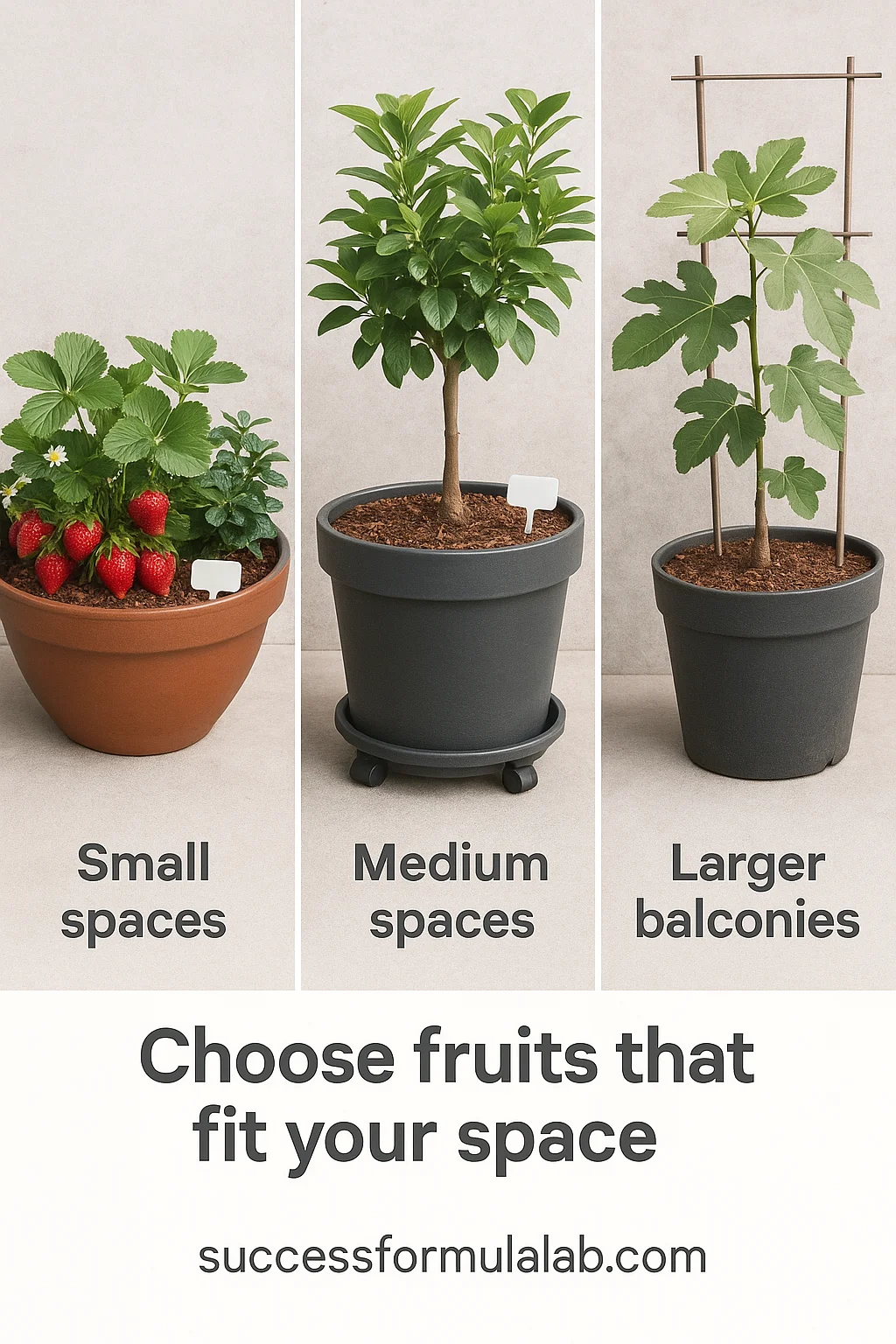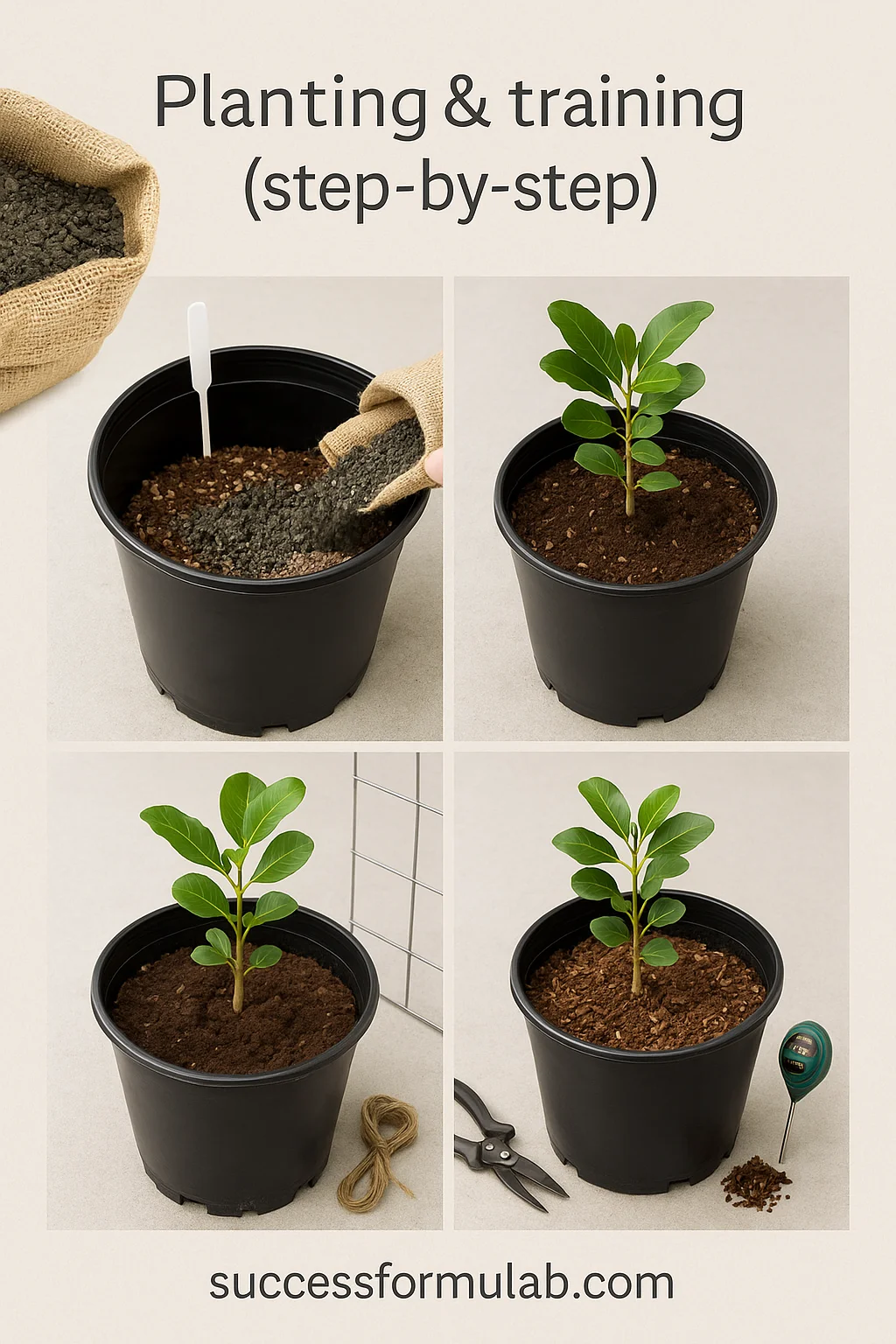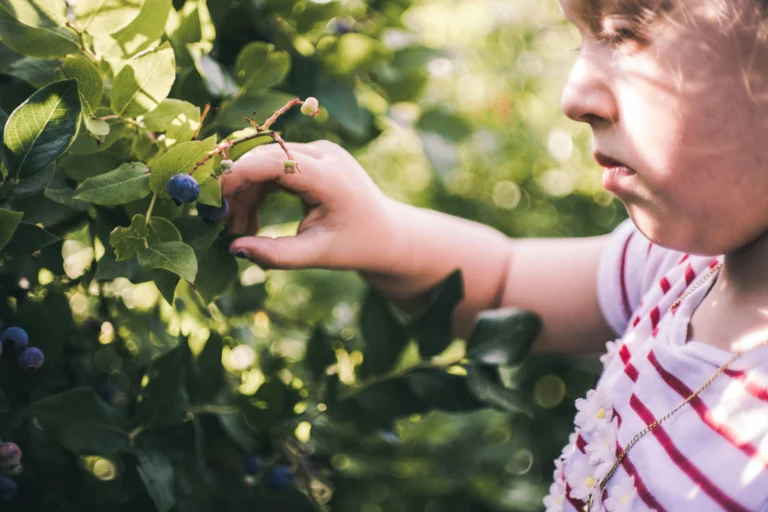A tiny orchard you can reach from your doorway

A Mini Fruit Garden lets you harvest bowls of fruit from balconies, courtyards, and small beds by matching the right varieties to your climate, using smart containers and soil, and following a simple weekly rhythm.
This Mini Fruit Garden guide gives you everything you need—plant lists, pot sizes, soil “recipes,” pruning basics, watering and feeding calendars, clean IPM, and quick ways to use your harvest.
Why a Mini Fruit Garden works (even in tight spaces)
You control soil and water. Containers and small beds let you dial in drainage and pH—huge for blueberries and citrus.
Dwarfing rootstocks keep trees compact. You shape trees to fit the space you have, not the other way around.
Staggered harvests. Pair one dwarf tree with two berry types and everbearing strawberries, and you’ll snack from spring through fall.
Low lift, high joy. Once planted and mulched, you’re maintaining—not fighting—your garden.
Quick-start roadmap
Pick two or three fruits to start
Choose one dwarf tree (apple, peach, fig, or citrus depending on climate), one berry (blueberry or raspberry), and an everbearing strawberry bowl. A focused menu builds momentum.
Match plants to sun and climate
Aim for 6–8 hours of direct sun. If your site is breezy or shaded, select tougher, container-friendly choices (figs, strawberries, blueberries with acidic mix) and skip high-disease apples.
Right-size the pot and soil
Use the tables below. Fruit hates soggy roots; your mix should be airy, well-drained, and mulched to buffer heat.
Set a simple rhythm
Weekly: check moisture, pick fruit, flip a few leaves to scout pests.
Monthly (growing season): light shaping cuts, top up mulch, feed as scheduled.
Seasonal: protect during heat spikes or hard freezes; roll citrus/figs indoors if needed.
Choose fruits that fit your space

Dwarf apples & pears (temperate)
Why you’ll like them: familiar flavor; espalier looks elegant against a fence or wall.
What to know: many apples/pears need a compatible pollination partner; pick two varieties that bloom together or use self-fertile options where available.
Container: 15–25 gallons; train as cordon/espalier to save space.
Peaches, nectarines & plums (stone fruit)
Why you’ll like them: fragrant, dessert-quality fruit you can reach without ladders.
What to know: peaches are typically self-fertile; thin early so branches don’t snap; keep canopies open for airflow.
Container: 15–25 gallons; open-center training works well.
Figs & citrus (heat lovers)
-
Why you’ll like them: figs thrive in heat and forgive missed waterings; citrus offers perfume and winter cheer indoors.
-
What to know: bring citrus inside before frost; figs are generally self-fertile and container-friendly.
-
Container: 15–25 gallons; prioritize drainage and a wheeled caddy.
Blueberries (acid lovers)
-
Why you’ll like them: container culture solves the pH problem; fall foliage glows.
-
What to know: best yields with two cultivars; keep pH 4.5–5.5; rainwater helps prevent salt buildup.
-
Container: 10–15 gallons; use an acidic mix (recipe below).
Raspberries & blackberries (compact/primocane)
Why you’ll like them: fast to fruit, simple cane pruning, high reward per pot.
What to know: choose compact or primocane types; provide a slim trellis or ring.
Container: 10–15 gallons.
Strawberries (everbearing)
Why you’ll like them: first to fruit, last to quit, and perfect for bowls and baskets.
What to know: refresh crowns every 2–3 years.
Container: 12–18″ wide; 5–8 crowns in an 18″ bowl.
Containers, drainage & soil mixes
Pot size & spacing guide
| Crop | Container Size (gal) | Approx. Diameter | Setup Tips |
|---|---|---|---|
| Dwarf apple/pear/peach | 15–25 | 16–22″ | Stake/espalier; heavy pot resists wind |
| Fig/citrus | 15–25 | 16–22″ | Sharp drainage; use a caddy |
| Blueberry | 10–15 | 14–18″ | Acidic mix; rainwater ideal |
| Raspberry/blackberry | 10–15 | 14–18″ | Slim trellis or cane ring |
| Strawberry bowl | 5–7 | 12–18″ | Replace plants every 2–3 yrs |
Drainage reality check: cover holes with mesh, not gravel. Gravel creates a perched water table that holds water higher in the pot.
Soil mix “recipes” that work
| Mix | Ingredients (by volume) | Why it works |
|---|---|---|
| Standard fruit tree | 40% quality potting mix, 30% fine bark, 20% compost, 10% perlite | Air + structure + steady nutrition |
| Blueberry (acid) | 40% peat/coco, 30% fine bark, 20% composted pine fines, 10% perlite; add elemental sulfur per label | Low pH, moisture-holding, still airy |
| Strawberry/berry | 50% potting mix, 25% compost, 15% perlite, 10% vermiculite | Even moisture, gentle drainage |
Mulch: add 1–2″ of fine bark or straw (off the trunk) to buffer heat and reduce watering swings.
Planting & training (step-by-step)

Planting in containers
Pre-soak media so it’s uniformly damp.
Line drainage holes with mesh; avoid saucers during heavy rain.
Set the plant at its original soil line; do not bury the graft on trees.
Backfill & firm gently to remove air pockets.
Water deeply until you see runoff; then mulch.
Stake or tie with soft ties; train branches early while wood is flexible.
Training styles
Cordon/Espalier (apples/pears)
Goal: one leader with short, fruit-heavy spurs along wires.
When: structural cuts in late winter; small summer snips to contain vigor.
Open-center (peach/nectarine)
Goal: 3–4 main arms and sunlight in the middle.
When: late winter plus summer thinning cuts to keep fruit within reach.
Cane management (brambles)
Goal: remove spent floricanes; tip primocanes to branch.
When: tip canes at waist height; prune out old canes after harvest.
Watering & feeding without guesswork
Seasonal schedule at a glance
| Season | Watering | Feeding | Notes |
|---|---|---|---|
| Early spring | Even moisture as buds swell | Slow-release fruit fertilizer per label | Keep salts low |
| Late spring–summer | Check daily in heat; deep soak 2–4×/week | Light monthly liquid feed if needed | Mulch reduces swings |
| Fall | Taper water as temps drop | Stop nitrogen 6–8 weeks pre-frost | Encourage hardening |
| Winter (dormant) | Minimal; don’t let rootball bone-dry | None | Protect roots from freeze-thaw |
pH targets
| Crop | Target pH |
|---|---|
| Blueberries | 4.5–5.5 |
| Strawberries | 5.5–6.5 |
| Most fruit trees | 6.0–7.0 |
A cue you’ll trust: lift the pot a little. Surprisingly light = water now. Slightly heavy and leaves are perky = wait.
Pollination, fruit set & heat stress
Self-fertile vs. cross-pollinated
Often self-fertile: peaches, figs, many citrus.
Often need partners: many apples/pears; some plums; blueberries yield better with two varieties.
Hand-pollination for containers
On still mornings, touch blooms with a soft brush or cotton swab, moving pollen bloom-to-bloom. It’s quick and often boosts set on breezeless balconies.
Chill hours & heat waves
Match varieties to your winter chill hours. In hot regions, clip a 30–40% shade cloth to a simple frame for afternoon protection and water early in the day to reduce stress.
Pests & diseases (Simple, Clean IPM)
Keep it preventive and light-touch. Your Mini Fruit Garden stays productive when you do a little, often.
Monitor & prevent
Flip leaves weekly; look for aphids, mites, leafrollers, mildew.
Keep mulch tidy; remove fallen fruit.
Sanitize pruners between plants; prune for airflow.
Exclusion
Row cover or insect-exclusion netting after bloom keeps pests off ripening fruit.
Bird net with large mesh prevents tangling and still protects.
Soft controls
Insecticidal soap for aphids and mites (cover leaf undersides).
Horticultural oil during dormant season for scale/eggs.
Bt (Bacillus thuringiensis) for caterpillars before they roll leaves.
Neem on soft-bodied pests (evening applications; follow labels).
When to escalate
Identify the exact issue (extension/IPM guides help), then choose the least disruptive control first.

Group pots together, wrap with burlap or a frost blanket, and raise them off concrete to reduce freeze–thaw stress.
Water lightly on thaw days—frozen, bone-dry roots are vulnerable.
Bring citrus and tender figs indoors before your first hard freeze; they’re the most cold-sensitive parts of a Mini Fruit Garden.
If summers scorch
Use light-colored pots or shade the sunny side with a board to keep root zones cooler.
Deep morning watering plus afternoon shade cloth helps plants ride out heat spikes.
Maintain 2″ mulch and avoid mid-day fertilizing; feed in the cool of morning or evening.
Harvest, yield & simple storage
Ripeness cues
Apples/pears: seeds brown; fruit releases with a gentle twist.
Peaches/nectarines: rich perfume, full ground color, slight give.
Figs: droop and soften; the neck yields.
Blueberries: fully blue with dusty bloom—wait a few days after coloring.
Strawberries: red to the cap; pick with a bit of stem for longer keeping.
Expected yields (after establishment)
One dwarf tree: 5–25+ lb, cultivar and care dependent.
Blueberries/raspberries: ½–3+ lb per container plant.
Strawberries: handfuls weekly in season from an 18″ bowl.
Use your harvest: quick, small-batch recipes
No-Cook Strawberry Freezer Jam
| Ingredient | Amount | Note |
|---|---|---|
| Strawberries, crushed | 4 cups | Very ripe |
| Sugar | 4 cups | Don’t reduce |
| Pectin (freezer type) | 1 package | As directed |
| Bottled lemon juice | 2 Tbsp | Brightness/acid |
Method: Stir sugar into fruit, mix in pectin per package, jar, and freeze. Refrigerate after thawing.
Blueberry Compote (refrigerated)
| Ingredient | Amount | Note |
|---|---|---|
| Blueberries | 3 cups | Fresh/frozen |
| Sugar or honey | ¼–½ cup | To taste |
| Lemon zest + juice | 1 tsp + 1 Tbsp | Brightness |
| Pinch of salt | — | Balances flavor |
Method: Simmer 10–12 minutes until glossy; cool and refrigerate up to a week.
Citrus–Herb Fruit Salt
| Ingredient | Amount |
|---|---|
| Coarse sea salt | 1 cup |
| Finely grated citrus zest (dried) | 1–2 Tbsp |
| Dried rosemary or thyme (crumbled) | 1 tsp |
Method: Dry zest completely; mix with salt and herb; store airtight.
Budget & time: what to expect
Startup per container tree: $60–$180 (pot, mix, plant, stake, mulch).
Berries: $25–$60 per container.
Recommended Resources
The Self-Sufficient Backyard
Compact, practical layouts for food, water, and small-space projects that complement container fruit gardening. Plan your small-space homestead.
AquaTower Vertical Garden
Grow strawberries and herbs upward to free ground space for dwarf trees; water-efficient and balcony-friendly. Grow more in less space.
Medicinal Garden Kit
Add a simple herb bed for teas and pantry remedies that pair with fresh fruit preserves. Start your herb patch.
The Lost Superfoods
Old-school preservation ideas for turning balcony harvests into shelf-stable staples. Preserve your surplus.
Annual: fertilizer, mulch refresh, occasional media top-ups.
Time: 1–2 hours/month in season; a bit more on planting and pruning days.
Save money: choose quality containers (fabric or sturdy resin), add a caddy once, and protect pots through winter so they last years.
Troubleshooting quick list
Blueberry leaves yellowing (green veins)? pH likely too high. Acidify gently; flush salts with rainwater if possible.
Figs dropping fruit? Irregular watering or heat stress. Deep morning soak, consistent mulch.
Peach leaf curl? Remove affected leaves; improve airflow; water at soil level; plant resistant cultivars next time.
Aphids clustering on tips? Rinse with a hose stream, then soap spray; encourage lady beetles by avoiding harsh broad-spectrum sprays.
Rootbound tree? Up-pot one size or root-prune lightly while dormant; refresh 25–30% of the mix.
FAQ: Mini Fruit Garden
What is a Mini Fruit Garden?
A compact planting—dwarf trees and berries grown in containers or small beds—designed to fruit heavily in limited space.
Can you grow fruit on a balcony?
Yes. Use 10–25 gallon pots, full sun, and sturdy staking or espalier. A caddy helps with wind and seasonal rotation.
Which fruits are easiest for beginners?
Strawberries, blueberries (with acidic mix), figs, and dwarf peaches are forgiving and highly productive in pots.
Do you need two plants for pollination?
Sometimes. Many apples/pears need compatible partners; peaches/figs/citrus are often self-fertile. Blueberries set better with two cultivars.
How often should you feed container fruit?
Mix in slow-release at planting, then add light monthly liquid feeds in peak growth if leaves pale or growth stalls. Stop nitrogen 6–8 weeks before frost.
What size pot for a dwarf tree?
Start at 15–25 gallons. Bigger roots = better fruit and fewer watering crises.
How do you overwinter pots?
Group, wrap, raise off concrete, and water lightly during thaws. Bring citrus/figs indoors in cold zones.
Can you keep trees small without losing yield?
Yes. Cordon/espalier and open-center systems focus energy into well-lit fruiting wood—often improving fruit quality.
How long until the first harvest?
Many berries produce in year one; dwarf trees may flower lightly the first year but reach meaningful crops by years 2–3 with good care.
Choose one dwarf tree, one berry, and one strawberry bowl. Use the soil recipe that matches each crop, plant at the correct depth, and set reminders for weekly checks and monthly touch-ups. That’s your Mini Fruit Garden launch plan.
Want a one-page printable for your Mini Fruit Garden with:
the exact soil recipe for your containers,
a feeding & watering calendar keyed to temperature, and
a quick pest ID sheet you can tape to your planter?
Tell me your region/climate, sun exposure, and container sizes, and I’ll tailor a compact checklist so your Mini Fruit Garden harvest is smooth from transplant to table.

